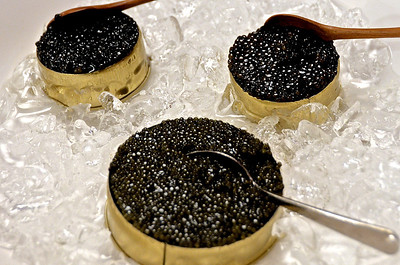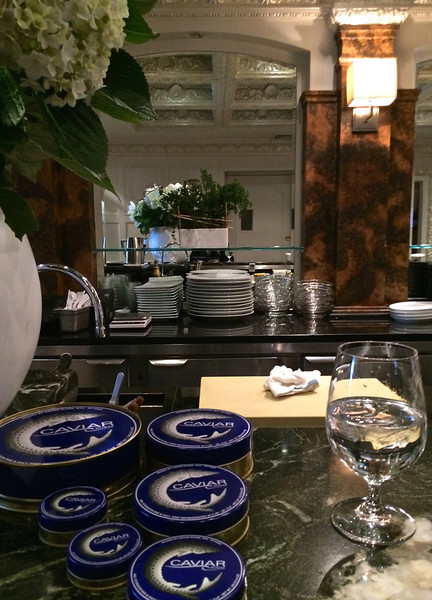 Caviar is one of those foods that we’re supposed to love. Costly and rare, it’s considered the height of luxury and sophisticated dining. Receive a complimentary blini topped with a dollop of creme fraiche and sprinkling of tiny, flame-colored, salty orbs and you might think, “Wow! Caviar! This restaurant knows how to make its diners feel special!” Then again, you might also think, “Gross. Fish eggs.”
Caviar is one of those foods that we’re supposed to love. Costly and rare, it’s considered the height of luxury and sophisticated dining. Receive a complimentary blini topped with a dollop of creme fraiche and sprinkling of tiny, flame-colored, salty orbs and you might think, “Wow! Caviar! This restaurant knows how to make its diners feel special!” Then again, you might also think, “Gross. Fish eggs.”
For years I’ve felt neutral about caviar. More often than not, I’ve consumed tough, gritty, low quality roe, the stuff that makes people say, “Eew. Fish eggs.” On very rare occasions I’ve sampled the luxurious, melt-in-your-mouth delicacy that makes people drool. Two weeks ago I had the latter experience when sent on a mission to obtain caviar for a friend’s Scandinavian-themed party.
 Dressed in my workday uniform of jeans, black sweater, faded black t-shirt and running shoes, I schlepped over to Caviar Russe in Midtown. Up the marble staircase I climbed, with each step wondering if I shouldn’t have worn something slightly nicer or cleaner. Seriously, what had I stepped in on my way over here? Greeted by staff wearing suits and ties, I realized that I might be the grubbiest person ever served there.
Dressed in my workday uniform of jeans, black sweater, faded black t-shirt and running shoes, I schlepped over to Caviar Russe in Midtown. Up the marble staircase I climbed, with each step wondering if I shouldn’t have worn something slightly nicer or cleaner. Seriously, what had I stepped in on my way over here? Greeted by staff wearing suits and ties, I realized that I might be the grubbiest person ever served there.
Fashion faux pas aside, tasting roe at Caviar Russe proved fairly enlightening. I learned that with caviar, you do get what you pay for. The moderately priced caviars were pleasant but no match for the pricey ossetra, which was smooth, nutty and otherworldly. Similar to the prized beluga, ossetra comes from sturgeon.
I also discovered that these petite eggs glide off a mother of pearl spoon but stubbornly cling to wood and stainless steel. In the past I’d been told that you serve caviar on mother of pearl so that no other flavors taint the eggs. So much for that theory. I likewise confirmed what I’d long suspected—caviar is a precious treat, one that, due to cost and issues of sustainability, should be consumed sparingly.
SAUTEED SHAD ROE
From Fish Market (Running Press, 2013)
Serves 4
Sautéed roe is one of those delicacies of the past rarely encountered in the present. Note that you’ll need a roe mass/roe still covered in membrane. Can’t find this essential ingredient? You can always buy a tin of salmon or trout roe and sprinkle the caviar over hors d’oeuvres, salads or pasta.
12 ounces shad roe
1/2 stick butter
2 tablespoons freshly squeezed lemon juice
Salt, to taste
White pepper, to taste
You’ll begin by melting the butter in a nonstick frying pan over medium heat. Swirl it around the pan and then add the roe.
Cook the roe on one side until lightly browned, about 3 minutes. Turn over and allow the other side to brown, about 3 minutes. When finished, the centers should look pink.
Remove the roe from the pan. Add the lemon juice to the remaining butter in the pan and whisk together over medium heat for 1 minute. Pour the liquid over the roe and season with salt and white pepper. When finished, you’ll have enough to serve 4.